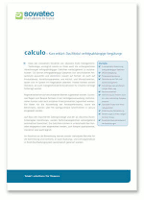In brief: The calculo "performance based fees" module
Thanks to the innovative use of Business Rules Technology, calculo makes it possible to automate even the most extensive performance fee settlements to the greatest possible degree and lowest level of detail.
You can evaluate and calculate performance fees from different points of view: from the partner as well as the product level. Conditional parameters, such as cap, floor, hurdle rate, high water mark and other features, can be represented on the system through rule sets.
At the same time, standard and custom rules can be stored for individual contracts. Rules can be assigned at various levels – including at the partner (e.g. asset manager), institutional customer or financial product level. Data used to evaluate the performance of the funds, as well as benchmarks, can be fed into calculo via configurable interfaces.
Performance fee calculations are automated to a large degree, based on the imported data and the associated business rules conditions. They can be calculated or accrued over a variety of periods, e.g. quarterly, monthly or even daily.
Custom settlements, monitoring reports as well as booking and payment triggers can be generated automatically in your accounting system after the calculation.
Benefits
- Automate performance fee settlement
- Increase efficiency
- Accelerate your processes
- Optimise time and cost management
- Eliminate laborious manual calculations
- Ensure auditability
- Minimise errors through single or multi-level approval processes
- Employ human resources effectively
- Ease the burden on specialist departments
- Calculations on deepest granular level
- Detailed traceability of calculations
Methods and parameters
In principle, calculo can calculate all types of performance-based fees, as long as the data required for the calculation can be imported into calculo.
The calculation is based on a percentage (out)performance, measured against the base volume, e.g. Assets under Management (AuM) and Total Net Assets (TNA).
To determine the applicable percentage one of the following methods can be used:
- Scales and levels – relating to the amount of (out)performance
- Hurdle rates – equivalent to minimum performance divided by the starting threshold
- Cap – maximum performance reward
- Floor – minimum performance reward
Furthermore, high watermarks are supported.
Negative performance can be used to trigger customer credits.
Negative performance can also be carried forwards from one year to the next.
Methods
calculo supports the calculation of NAV-based performance data.
In this case, only the basic data needs to be imported, i.e. NAV and where applicable the benchmark (BM).
- Performance = NAV(t) / NAV(t-1)
Outperformance (Benchmark based) = NAV(t) / NAV(t-1) - BM(t) / BM(t-1)
- OP Fee = Rate * Outperformance * Base volume
Variations of this calculation method can be configured using the business rules approach to condition setting
- Daily, weekly, monthly accruals (calculations)
- Monthly, quarterly, half yearly and annual calculations [EH1] (withdrawals)
Further calculation-relevant parameters
- Data frequency, i.e. availability of basic data: daily, weekly, monthly
- Offset dates, i.e. valuation dates used for the calculation: t0, t-1, t-2, t-3
- Day-count practices: 30/360, act/360, act/365, act/act
- Holiday treatment, e.g. calculation on previous or next valuation date
- VAT, Yes/No and individual configuration of applicable rates
- High watermark update interval



